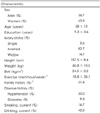1. Gonzalez CA. The European Prospective Investigation into Cancer and Nutrition (EPIC). Public Health Nutr. 2006. 9(1A):124–126.

2. Kim WY, Kim JE, Choi YJ, Huh KB. Nutritional risk and metabolic syndrome in Korean type 2 diabetes mellitus. Asia Pac J Clin Nutr. 2008. 17:Sl. 47–51.
3. Getz GS, Reardon CA. Nutrition and Cardiovascular Disease. Arterioscler Thromb Vasc Biol. 2007. 27:2499–2506.

4. Chen CM, Zhao W, Yang Z, Wu Y, Hong L. The role of dietary factors in chronic disease control in China. Obes Rev. 2008. 9:S1. 100–103.

5. Willett W. Nutritional epidemiology. 1998. 2nd Ed. Oxford University Press;74–91.
6. Lee GS, Paik HY, Sun YM, Joung HJ. Response Experiences with a Semi-Quantitative Food Frequency Questionnaire: A Qualitative Study using Cognitive Interview. Korean J Nutr. 2007. 40(6):566–575.
7. Kim SH. Nutrition of spice and condiments. Korean J Dietary Culture. 1990. 5(3):381–389.
8. Korea Health Industry Development Institute. The Third Korea National Health & Nutrition Examination Survey (KNHANES III), 2005 - Nutrition Survey. 2006.
9. National Rural Resources Development institute. R.D.A. Food composition table, seventh revision. 2006.
10. Kim MK, Lee SS, Yo A. Reproducibility and validity of a self administered semiquantitative food frequency questionnaire among middle-aged men in Seoul. Korean J Community Nutrition. 1996. 1:376–394.
11. The Korean Nutrition society. Evaluation of nutrition program CAN-Pro 2.0. 2002.
12. Willett W, Stampfer MJ. Total energy intake: implications for epidemiologic analyses. Am J Epidemiol. 1986. 124:17–27.

13. Shim JE, Ryu JY, Paik HY. Contribution of seasonings to nutrient intake assessed by food frequency questionnaire in adjults in rural area of Korea. Korean J Nutr. 1997. 30(10):1211–1218.
14. Bosetti C, Negri E, Franceschi S, Talamini R, Montella M, Conti E, Lagiou P, Parazzini F, La Vecchia C. Olive oil, seed oils and other added fats in relation to ovarian cancer (Italy). Cancer Causes Control. 2002. 13(5):465–470.
15. Brunner EJ, Rees K, Ward K, Burke M, Thorogood M. Dietary advice for reducing cardiovascular risk. Cochrane Database Syst Rev. 2007. (4):CD002128.

16. Sacks FM, Svetkey LP, Vollmer WM, Appel LJ, Bray GA, Harsha D, Obarzanek E, Conlin PR, Miller ER III, Simons-Morton DG, Karanja N, Lin PH. DASH-Sodium Collaborative Research Group. Effects on blood pressure of reduced dietary sodium and the Dietary Approaches to Stop Hypertension (DASH) diet. N Engl J Med. 2001. 344(1):3–10.

17. Conlin PR, Chow D, Miller ER III, Svetkey LP, Lin PH, Harsha DW, Moore TJ, Sacks FM, Appel LJ. The effect of dietary patterns on blood pressure control in hypertensive patients: results from the Dietary Approaches to Stop Hypertension (DASH) trial. Am J Hypertens. 2000. 13(9):949–955.

18. Park KY, Lee JM, Moon SH, Jung KO. Inhibitory effect of Doenjang (fermented Korean soy paste) extracts and linoleic acid on the growth of human cancer cell lines. J Korean Soc Food Sci Nutr. 2000. 5(2):114–118.
19. Jung KO, Park SY, Park KY. Longer aging time increases the anticancer and antimetastatic properties of Doenjang. Nutrition. 2006. 22:539–545.

20. Kim JS. 2003. In : Bioactive properties of spice vegetables, Inje food science forum 6th; 5–33.
21. Ackermann RT, Mulrow CD, Ramirez G, Cardner CD, Morbidoni L, Lawrence VA. Garlic shows promise for improving some cardiovascular risk factors. Arch Intern Med. 2001. 61:813–824.

22. Voutilaninen S, Nurmi T, Mursu J, Rissanen TH. Carotenoids and cardiovascular health. Am J Clin Nutr. 2006. 83:1265–1271.

23. Millen AE, Subar AF, Graubard BI, Peters U, Hayes RB, Weissfeld JL, Yokochi LA, Ziegler RG. Fruit and vegetable intake and prevalence of colorectal adenoma in a cancer screening trial. Am J Clin Nutr. 2007. 86(6):1754–1764.








 PDF
PDF ePub
ePub Citation
Citation Print
Print





 XML Download
XML Download